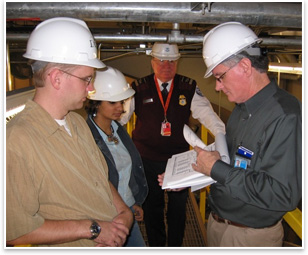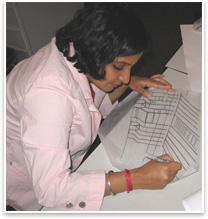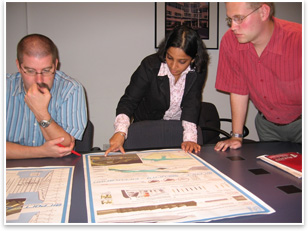Architecture Whiz Kids Receive Internship for Forward-thinking Airport Design
by Russell Boniface
Associate Editor
 Summary: Dallas-based Gresham, Smith and Partners has granted two MArch students a one-week, all-expense-paid internship to advance their award-winning airport design concept. The design received an honorable-mention award in the Airport Security Circulation Student Design Competition sponsored by the Association of Collegiate Schools of Architecture (ACSA) and the Department of Homeland Security (DHS). The design was selected by Gresham, Smith and Partners among eight submittals for being outside the box, creative, and forward-thinking in its concept for solving airport security concerns. Summary: Dallas-based Gresham, Smith and Partners has granted two MArch students a one-week, all-expense-paid internship to advance their award-winning airport design concept. The design received an honorable-mention award in the Airport Security Circulation Student Design Competition sponsored by the Association of Collegiate Schools of Architecture (ACSA) and the Department of Homeland Security (DHS). The design was selected by Gresham, Smith and Partners among eight submittals for being outside the box, creative, and forward-thinking in its concept for solving airport security concerns.
 Second-year Iowa State University architecture students Nandita Chakravarti and Zach May spent the week of October 9 with Gresham, Smith and Partner designers, working on ways to advance their award-winning design. A charrette allowed the students to work with architects to exchange ideas, and the students have also been invited to collaborate on a current Gresham, Smith and Partners security project at Reno/Tahoe International Airport. Second-year Iowa State University architecture students Nandita Chakravarti and Zach May spent the week of October 9 with Gresham, Smith and Partner designers, working on ways to advance their award-winning design. A charrette allowed the students to work with architects to exchange ideas, and the students have also been invited to collaborate on a current Gresham, Smith and Partners security project at Reno/Tahoe International Airport.
A recruiting effort
Aviation architecture is one of Gresham, Smith and Partners’ eight markets. Matt Frankel, aviation marketing specialist at the Dallas-based firm, says internship is a great opportunity for the company to look at up-and-coming design students. “We look for ways to get more involved with architecture students,” he says. “We volunteered to fund the internship ourselves because we thought it was an important enough venture. We are looking at it as a recruiting effort.”
 The Airport Security Circulation competition drew 100 submittals and encouraged students to look at ways to improve the flow of tomorrow’s airports while coming up with creative ways to solve post-9/11 security requirements. Gresham, Smith tapped into the competition’s award-winners for its internship. After limiting their consideration geographically, the firm’s architects chose the one that they thought spoke to the problems they themselves see in airport terminals, and offered Chakravarti and May the internship. “These students had a grasp on what airport issues were and how to solve them,” enthuses Frankel. The Airport Security Circulation competition drew 100 submittals and encouraged students to look at ways to improve the flow of tomorrow’s airports while coming up with creative ways to solve post-9/11 security requirements. Gresham, Smith tapped into the competition’s award-winners for its internship. After limiting their consideration geographically, the firm’s architects chose the one that they thought spoke to the problems they themselves see in airport terminals, and offered Chakravarti and May the internship. “These students had a grasp on what airport issues were and how to solve them,” enthuses Frankel.
 Design responds to circulation, security issues Design responds to circulation, security issues
What made their design stand out?
The two students looked at ways to allow:
- Travelers to enter an airport from different points through a series of steel tubes, be contained in a central area, then disperse following the security checkpoint
- Different sections in each tube for check-in, waiting, security, and post-security
- Each tube to run through a series of large blast-deflecting concrete walls (each wall has a core to allow the tube through). In a catastrophic event, each section within the tube could be sealed off
- A vertical circulation system that would direct a blast upwards and outwards rather than confining it within the tube.
 “What made their design stand out for us is that it’s a forward thinking response to large-scale, catastrophe-type airport events,” explains Frankel. “It is the type of thing that the DHS is saying that it is not prepared for right now. Airports can screen out the guns and knives, but what about the car bomb that pulls up curbside and detonates and takes out entire terminals? What about the passenger with explosives on his or her backpack who makes it to the security checkpoint and, although gets caught, can still remotely detonate the device? It is forcing architecture students to look beyond beautiful designs and consider ways to mitigate terrorist attacks.” “What made their design stand out for us is that it’s a forward thinking response to large-scale, catastrophe-type airport events,” explains Frankel. “It is the type of thing that the DHS is saying that it is not prepared for right now. Airports can screen out the guns and knives, but what about the car bomb that pulls up curbside and detonates and takes out entire terminals? What about the passenger with explosives on his or her backpack who makes it to the security checkpoint and, although gets caught, can still remotely detonate the device? It is forcing architecture students to look beyond beautiful designs and consider ways to mitigate terrorist attacks.”
The innovative design’s future
The Chakravarti-May design is considered a “greenfield” airport design—it would be built from scratch. Frankel points out that new airports are rare, especially in the U.S., citing cost as the primary reason. “Most airports were built between the ’50s and ’70s,” explains Frankel, “and they are what they are. Many undergo renovation, expansion, and modification, but to go literally to fresh earth, tear it up, and construct an airport with runways and terminals is unheard of now in the U.S.”
So what becomes of the Chakravarti-May design, which also was done without cost considerations?
 Says Frankel, “There are certainly components of their design that can be incorporated into existing terminals, like cordoning off different areas with secure blast-deflecting walls. In our charrette, our designers here in Dallas brought in a little bit of reality to their design, but it was also a positive, open exchange of ideas. We also asked the students to work on a security project we have at Reno/Tahoe International Airport. They are taking what they learned about circulation and security and incorporating that into potential ticket lobby designs.” Says Frankel, “There are certainly components of their design that can be incorporated into existing terminals, like cordoning off different areas with secure blast-deflecting walls. In our charrette, our designers here in Dallas brought in a little bit of reality to their design, but it was also a positive, open exchange of ideas. We also asked the students to work on a security project we have at Reno/Tahoe International Airport. They are taking what they learned about circulation and security and incorporating that into potential ticket lobby designs.”
And who knows what these two pioneering architecture students can come up with in a short time. Notes Frankel: “These are master’s-level students who developed their award-winning concept with diagrams and models in just six weeks—a really condensed schedule. And they were still able to create an incredible design!”
|


 Summary:
Summary: Second-year Iowa State University architecture students Nandita Chakravarti and Zach May spent the week of October 9 with Gresham, Smith and Partner designers, working on ways to advance their award-winning design. A charrette allowed the students to work with architects to exchange ideas, and the students have also been invited to collaborate on a current Gresham, Smith and Partners security project at Reno/Tahoe International Airport.
Second-year Iowa State University architecture students Nandita Chakravarti and Zach May spent the week of October 9 with Gresham, Smith and Partner designers, working on ways to advance their award-winning design. A charrette allowed the students to work with architects to exchange ideas, and the students have also been invited to collaborate on a current Gresham, Smith and Partners security project at Reno/Tahoe International Airport. The Airport Security Circulation competition drew 100 submittals and encouraged students to look at ways to improve the flow of tomorrow’s airports while coming up with creative ways to solve post-9/11 security requirements. Gresham, Smith tapped into the competition’s award-winners for its internship. After limiting their consideration geographically, the firm’s architects chose the one that they thought spoke to the problems they themselves see in airport terminals, and offered Chakravarti and May the internship. “These students had a grasp on what airport issues were and how to solve them,” enthuses Frankel.
The Airport Security Circulation competition drew 100 submittals and encouraged students to look at ways to improve the flow of tomorrow’s airports while coming up with creative ways to solve post-9/11 security requirements. Gresham, Smith tapped into the competition’s award-winners for its internship. After limiting their consideration geographically, the firm’s architects chose the one that they thought spoke to the problems they themselves see in airport terminals, and offered Chakravarti and May the internship. “These students had a grasp on what airport issues were and how to solve them,” enthuses Frankel. Design responds to circulation, security issues
Design responds to circulation, security issues
 Says Frankel, “There are certainly components of their design that can be incorporated into existing terminals, like cordoning off different areas with secure blast-deflecting walls. In our charrette, our designers here in Dallas brought in a little bit of reality to their design, but it was also a positive, open exchange of ideas. We also asked the students to work on a security project we have at Reno/Tahoe International Airport. They are taking what they learned about circulation and security and incorporating that into potential ticket lobby designs.”
Says Frankel, “There are certainly components of their design that can be incorporated into existing terminals, like cordoning off different areas with secure blast-deflecting walls. In our charrette, our designers here in Dallas brought in a little bit of reality to their design, but it was also a positive, open exchange of ideas. We also asked the students to work on a security project we have at Reno/Tahoe International Airport. They are taking what they learned about circulation and security and incorporating that into potential ticket lobby designs.”